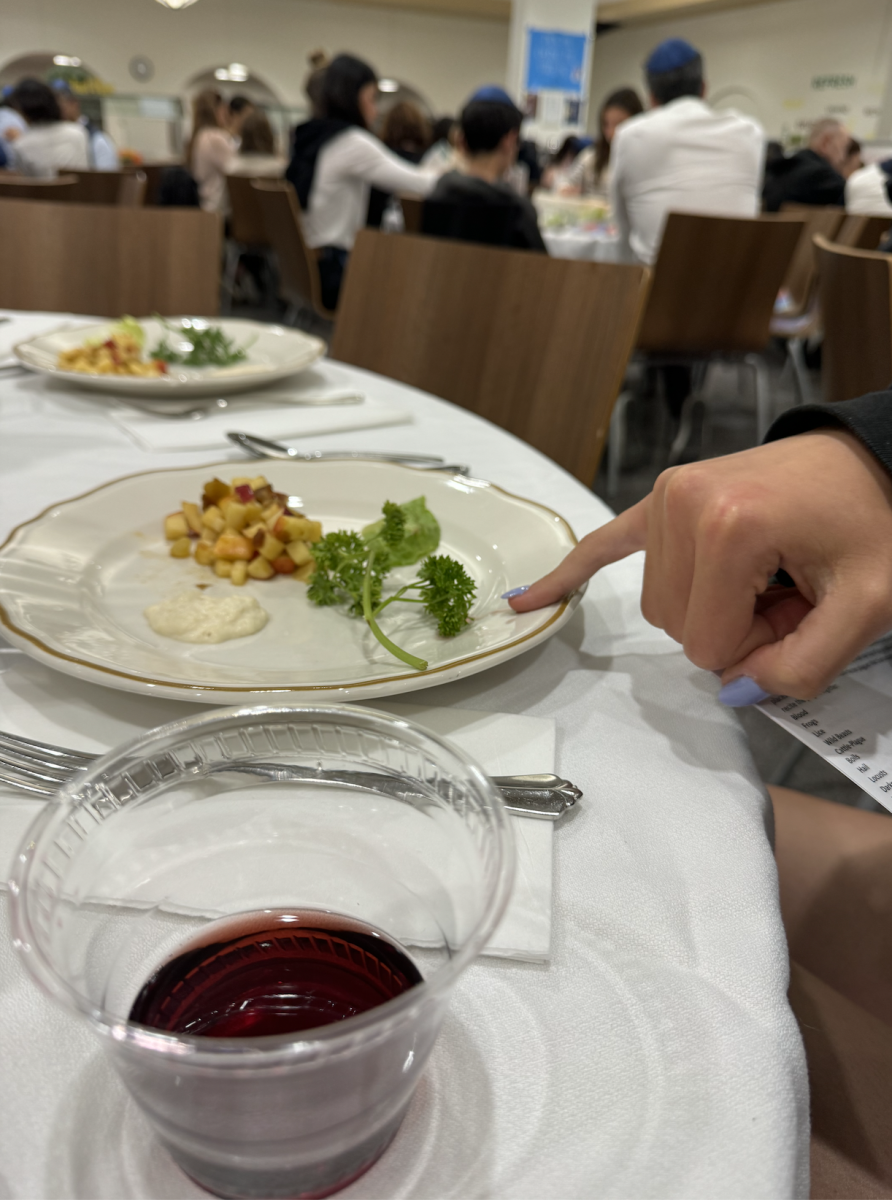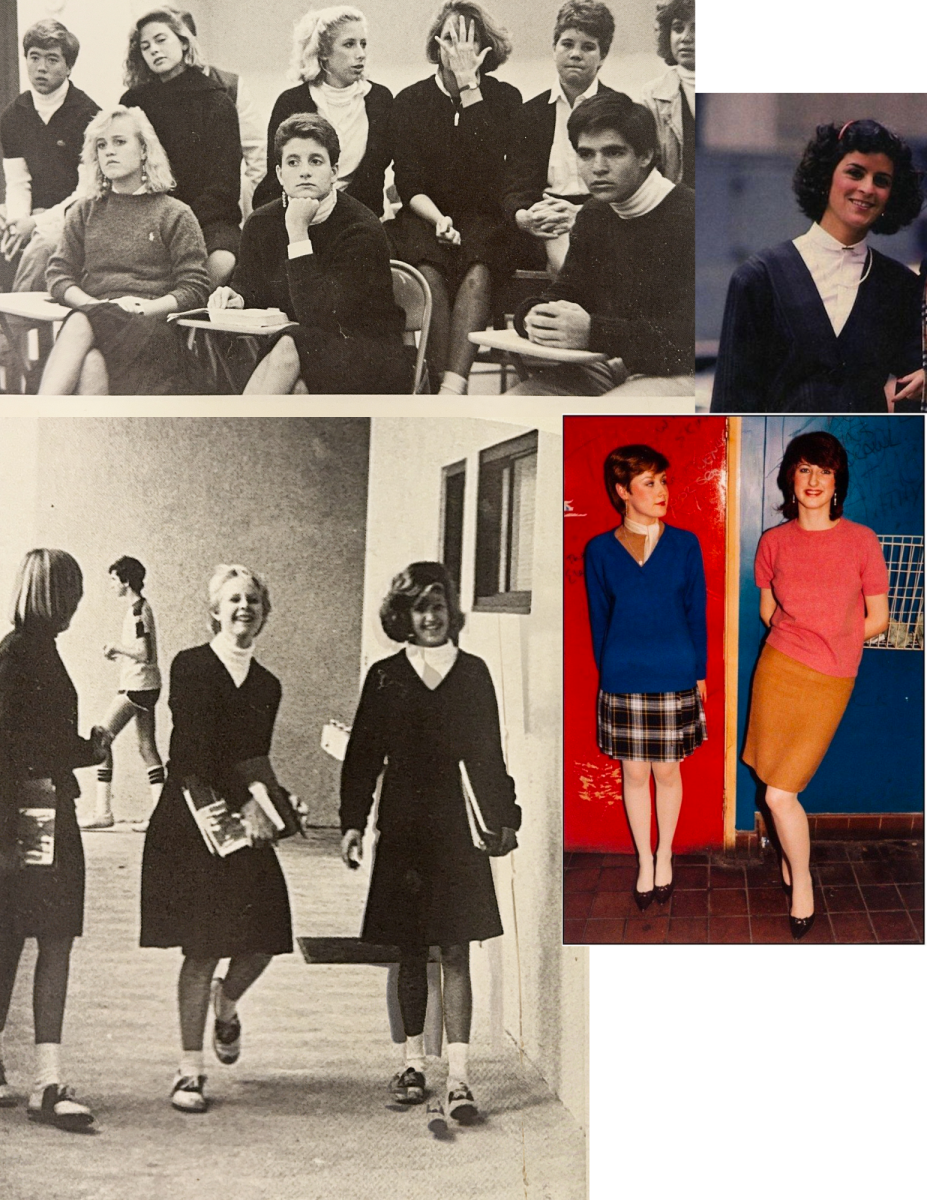Eliana Leff (‘26) drove down Draper Avenue on a bright February morning at 7:50 AM with a coffee in her cup holder. Her little sister, Ariela Leff (‘28), sat in the passenger seat and drank a cup of hot chocolate while checking her phone. The two of them woke up early enough to secure a parking spot right next to the Bishop’s tennis courts and left little time to get ready in the morning. Getting ready in the car together once parked outside the School is more fun, anyway.
Sitting in her car, Eliana pulled out her mascara and flipped open the mirror in the sun visor. The two vibed to a tune — something by Lana Del Rey — while Ariela asked, “Can you help me with my hair?”
The sisters have bonded since Eliana got her license and started driving Ariela to school. Sometimes they have breakfast, sometimes coffee together, or a karaoke session while they navigate down the highway. This is their morning routine. Behind them, the Bishop’s buses rolled down the street, students inside.
According to a study by Professor of Psychology at San Diego State University Dr. Jean Twenge, “Driving around in a car just for fun is increasingly a thing of the past.” The percentage of students who drive has dropped from more than 70% in the 1970s to less than 50% in 2014. Some students nowadays are getting their licenses later, whereas some are getting them right away — here’s why.
Why Drive Now?
U.S. History courses teach the invention of the automobile to sophomores, and attentively watching slide after slide, this part of history catches some of their attention. “Cars,” Dr. Charissa Keup said to my classmates and me, “are associated with freedom.”
One major reason teenagers want to get their licenses as soon as they turn 16 is the independence that comes with it. “It gives me a lot of freedom and flexibility because I have a very busy schedule, so it’s much easier to drive myself everywhere. And, I can help out my parents by driving my sister and myself to school,” Eliana explained. We were hanging out in her car, a perfect, private seating area.
Many Bishop’s students dedicate their afternoons to extracurricular activities, whether on-campus or off. Students like Eliana, who do performing arts activities at School like theater, Bishop’s Singers, or orchestra often stay late on campus, sometimes even past 7:00 PM. Having your own means of transportation allows students to start their commute home as soon as these activities end.
Riley Brunson (‘25) regrets waiting to get her license. While she has completed her driver’s education course, she hasn’t tested for her permit or her license, and being a junior in high school, she has had no time to complete these steps. I barely caught her in time during a five-minute break for her to say, “If you’re thinking about waiting, just know it’s a mistake.” Soon after, she was whisked away by a costumer for a costume change during the busy hours of Hamlet tech rehearsal.
Jayden Zou (‘26), who plays on the Boys’ Varsity Volleyball Team, just started practicing with his team after school. As a student under 16 learning to drive with his permit, Jayden still takes the bus to and from school or has his mom drive him. The late bus leaves at 5:45 PM, so he spends a lot of time waiting around in the library. “Usually, if I have to do something after school, and [even if] it only takes 30 minutes, then I have to wait for the late bus,” which departs an additional hour later than the early bus, Jayden said. “But if I have my own car, I could just drive.” Jayden has grown sick of the wait. He wants a license.
Why Wait?
Some people, on the other hand, don’t find a license necessary. Sofia Hayden’s (‘25), father, World Languages Department Chair Mr. Ian Hayden, works at Bishop’s, and so she has no need for a bus ride to and from school. She and her father drive the same routes, and, hey, you only need a minimum of two people to speed down the carpool lane through early morning traffic.
Sofia doesn’t plan to get her license anytime soon. She’s a junior in high school, but the earliest she’s considering getting her license is in the second semester of her senior year. “I don’t really have time to get a license because of school and everything,” she said — the same reasoning as Riley. For her, however, “it’s just not a priority.”
While Sofia acknowledged that driving is associated with freedom, her parents are usually willing to drive her wherever she needs to go: to hang out with friends, Model United Nations conferences, and more. “It would be fun to eventually be able to drive myself, I guess,” she admitted.
Bella Combs (‘25), another junior who doesn’t have her license yet, agreed, “There’s just no time for a driver’s ed [education] course.”
Driving is a social activity, too. When Sofia drives with her dad, it’s a special bonding time for the two of them — side by side, facing the clogged freeway entrance into La Jolla, often chatting away to make the wait seem shorter. “Every morning [on the way] to school, we’re listening to something, we’re talking, or sometimes I’m doing homework,” Sofia described. “And on the way back home, there’s always a conversation.”
Getting Behind The Wheel
The beautiful city of La Jolla is a nightmare to drive in. Sometimes, slow drivers block traffic, and other times, there are careless drivers who speed and barely slow down at stop signs. Knowing when to press that gas pedal, turn on your signal lights, check your mirrors, brake, let other vehicles pass, and pass through yourself — there are many aspects of driving to practice and memorize.
Jayden had recently started training with a professional driver’s course, and at first, “It was kinda nerve-wracking,” he admitted.
“You’re so used to having someone next to you to call out things, but now you’re on your own,” Eliana added. When you’re in the practicing stage after passing the permit exam, this is necessarily an instructor or a person over the age of 25. When driving solo, it’s important to be that person for yourself and to stay aware of your surroundings at all times.
“It’s scary because what if you crash the car?” Jayden commented.
The prospects of accidents are what keeps some parents reluctant to give their children that golden car key to freedom.
“Nothing too bad has happened to me,” Eliana said. She has seen many things on the road before, but they weren’t a hazard to her safety. “There’s always reckless and dangerous drivers. No matter how loud your music is, or no matter what you’re listening to, [keep your] eyes on the road, always be focused.”
“When we’re young, we’re not too sure about some stuff that we do. We’re not that responsible yet,” Jayden added.
“Whoever’s in your car, you’re responsible for their life,” Eliana said. “And you’re responsible for your own life and for the people around you in other cars.” She concluded with a Spiderman reference, “With great power comes great responsibility. Know the power you have when you drive.”
Getting Your License: The Process
If you plan to get your license when you turn 16, you should start your driver’s education course a little before turning 15 and a half years old. Your first steps begin with acquiring a provisional instruction permit, which has a minimum age requirement of 15 and a half years old, according to the official California Department of Motor Vehicles (DMV) site.
To get this permit, you need to take an online driver’s education course to get a “certificate of completion/enrollment.” One popular online course is Aceable. Courses, depending on your pace, can take from a few days to a couple of hours. “After taking the course, I read the handbook around two times, took a few practice tests, and then I took [the permit test] and passed,” Eliana explained. By DMV official guidelines, you must take 30 hours of driver’s education (about the length of the course). There are, however, some ways to get around this requirement and speed up your process.
After you get your certificate, you have to apply for a California Driver’s License or ID Card. Then, make an appointment with your local DMV office, where you will provide identification, pay an application fee, take your ID photo, and take the Permit Test. To pass, you must get an 80% or higher on the exam.
Once you get your permit slip, you will spend a minimum of six months practicing driving with your slip. You must have completed six hours of professional driver training and at least 50 hours of driving practice with a licensed adult driver over the age of 25 before you get your license. Once you’ve fulfilled those requirements, you can schedule an appointment at your local DMV for a driving test.
Depending on your lifestyle, you may choose to start driving as soon as possible, or you may wait. The choice is yours.










